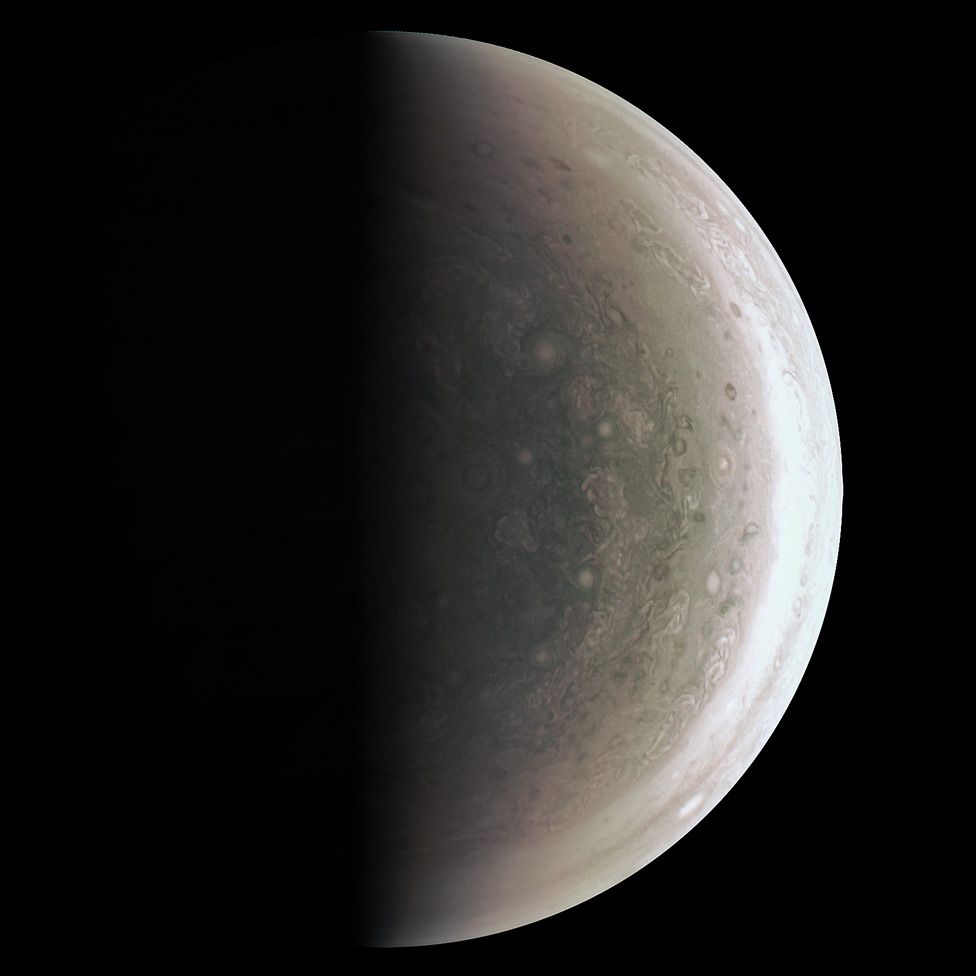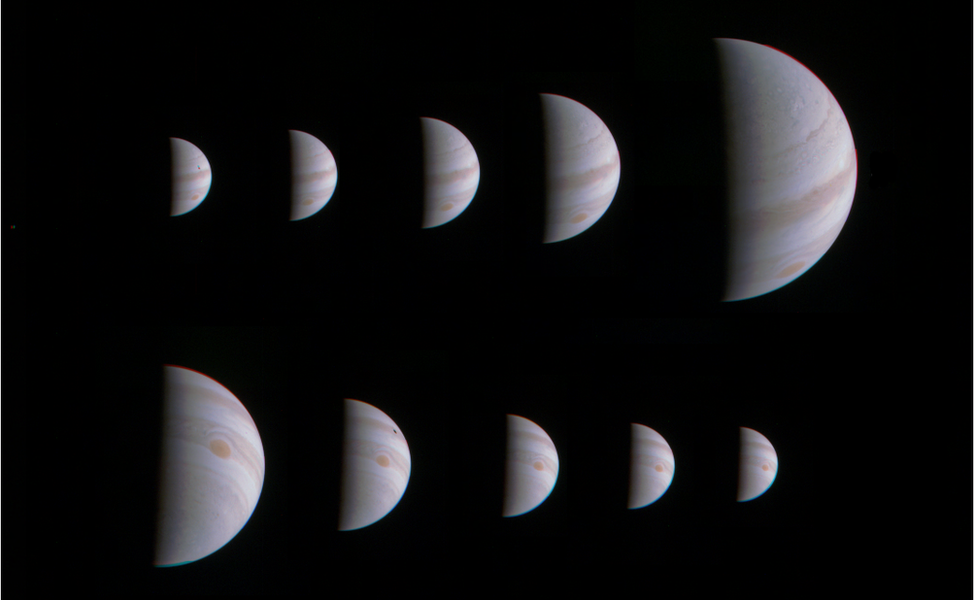It looks like you're using an Ad Blocker.
Please white-list or disable AboveTopSecret.com in your ad-blocking tool.
Thank you.
Some features of ATS will be disabled while you continue to use an ad-blocker.
share:
NASA has released spectacular images of its first close flyby of Jupiter , the flyby took the probe just 4,200km above the planet.

Images from Juno as it approaches and departs the planet.

An infrared shot of the Southern pole aurora.

Stunning.

Images from Juno as it approaches and departs the planet.

An infrared shot of the Southern pole aurora.

The pictures show the swirling clouds of the gas giant at both its poles - views that no previous mission has managed to acquire in such detail.
Juno captured the data last weekend as it made its first close approach to the planet since going into orbit in July. The flyby took the spacecraft just 4,200km above Jupiter's multi-coloured atmosphere. The 6MB of data gathered by Juno is still being analysed, but principal investigator Scott Bolton said new things were already obvious. "First glimpse of Jupiter's north pole, and it looks like nothing we have seen or imagined before," the Southwest Research Institute scientist said in a Nasa statement. "It's bluer in colour up there than other parts of the planet, and there are a lot of storms. "
There is no sign of the latitudinal bands or zones and belts that we are used to - this image is hardly recognisable as Jupiter. "We're seeing signs that the clouds have shadows, possibly indicating that the clouds are at a higher altitude than other features."
www.bbc.co.uk...
Stunning.
edit on 2-9-2016 by gortex because: corrected
a reply to: MarioOnTheFly
I think you may be right.
Just got in from work.
I think maybe you are mistaken ?
I think you may be right.
Just got in from work.
Just getting in before someone suggests the 2 white dots in the infa red are alien spacecraft?
Amazing Jupiter , what a giant this planet . I hope someday they find a way of making a video entering this inside this massive storm raging gas
giant.
Speculation of what I once heard that it contains like floating worlds inside , don't know if that's true , but I really would like to see it on camera .
Speculation of what I once heard that it contains like floating worlds inside , don't know if that's true , but I really would like to see it on camera .
originally posted by: Misterlondon
Just getting in before someone suggests the 2 white dots in the infa red are alien spacecraft?
Well...what do you think those dots are?
a reply to: 0bserver1
No its a single gravity well.
I keep wondering there might be a moonetesimal in the great red spot, though.
Speculation of what I once heard that it contains like floating worlds inside , don't know if that's true , but I really would like to see it on camera .
No its a single gravity well.
I keep wondering there might be a moonetesimal in the great red spot, though.
originally posted by: MysterX
originally posted by: Misterlondon
Just getting in before someone suggests the 2 white dots in the infa red are alien spacecraft?
Well...what do you think those dots are?
They're in focus, unlike the rest of the image. Must be imager artifacts. Any other images they show up in?
Stunning, Gives me something to show my children, just what, some of those tiny dots are, up in space. they are always asking to look through my
Telescope eyepiece. Love that priceless time
Probably with the nice pictures we had a disposal of sacrificed babies ashes into the eye-storm of the pole. They cannot afford this kind of rituals
on earth, maybe they tried to get weird action on more potent place, it all will reflect here after a while, we'll see. Funny, right, it was done when
Jupiter was in it's master potency through his 12 years cycle. I don't know, otherwise why to pass so close to the planet, just 2.600 miles, or
whatever they stated...
PICS, yeah, to upload them to FB, yeah, I am a carrot...
If not baby ashes, then small kittens, but I know they threw something sinister there!
PICS, yeah, to upload them to FB, yeah, I am a carrot...
If not baby ashes, then small kittens, but I know they threw something sinister there!
Dear NASA / mainstream haters... suck it up. These guys are doing the real scientific / exploratory work, while you just sit at your computer and cry
out "fake!" and "conspiracy!"
originally posted by: AugustusMasonicus
The first photo seems to be from a polar orbit which is a very cool perspective.
That it apparently what it's doing to get so close. It has to do kind of a suicide dive across the poles to avoid getting blasted by the magnetic fields.
originally posted by: MarioOnTheFly
a reply to: gortex
the pictures were taken from just 4,200km above the planet.
I think maybe you are mistaken ? On the link it says the first image was taken at 195 000 km. The flyby took the craft 4200 km above the surface...
It's likely these are just the first, 'rushes' though I should like to have seen the normal south polar picture side by side with the infra red one, that seems quite close.
a reply to: Argentbenign
Why even worry about sending ashes to Jupiter?
The sacred spaces on Earth have 100's & 1000's of years of connection -
en.wikipedia.org...
Plenty of Temples dedicated to Jupiter still around in Rome
Or
Iraq StarGate Key to 911 and Bush
ireport.cnn.com...
Or
IRAQ AND SYRIA: Illuminati infighting to control the STARGATE?
www.youtube.com...
Or they could even have exclusive use of the Pyramids, being the powerful Illuminati that they are
Now if you really want to go down that rabbit hole, what about Cassini?
saturn.jpl.nasa.gov...
Feel free to search ATS threads about the weirdness of Saturn
. They cannot afford this kind of rituals on earth, maybe they tried to get weird action on more potent place, it all will reflect here after a while, we'll see. Funny, right, it was done when Jupiter was in it's master potency through his 12 years cycle.
Why even worry about sending ashes to Jupiter?
The sacred spaces on Earth have 100's & 1000's of years of connection -
en.wikipedia.org...
Plenty of Temples dedicated to Jupiter still around in Rome
Or
Iraq StarGate Key to 911 and Bush
ireport.cnn.com...
Or
IRAQ AND SYRIA: Illuminati infighting to control the STARGATE?
www.youtube.com...
Or they could even have exclusive use of the Pyramids, being the powerful Illuminati that they are
Now if you really want to go down that rabbit hole, what about Cassini?
saturn.jpl.nasa.gov...
Feel free to search ATS threads about the weirdness of Saturn
Cassini–Huygens
From Wikipedia, the free encyclopedia Cassini–Huygens
NASA Mission duration Elapsed: 18 years, 10 months and 18 days from launch 12 years, 2 months and 1 day at Saturn En route: 7 years Primary mission: 4 years Extended missions: Equinox: 2 years Solstice: 3 years elapsed Expected end of life: 2017 Spacecraft properties Launch mass 5,712 kilograms (12,593 lb)[1] Dry mass 2,523 kilograms (5,562 lb)[2] Power ~880 watts (BOL)[3] ~670 watts (2010)[3] Start of mission Launch date October 15, 1997, 08:43:00 UTC Rocket Titan IV(401)B Launch site Cape Canaveral SLC-40 Orbital parameters Reference system Kronocentric Flyby of Venus (Gravity assist) Closest approach April 26, 1998 Distance 283 kilometres (176 mi) Flyby of Venus (Gravity assist) Closest approach June 24, 1999 Distance 6,052 kilometres (3,761 mi) Flyby of Earth-Moon system (Gravity assist) Closest approach August 18, 1999, 03:28 UTC Distance 1,171 kilometres (728 mi) Flyby of 2685 Masursky (Incidental) Closest approach January 23, 2000 Distance 1,600,000 kilometres (990,000 mi) Flyby of Jupiter (Gravity assist) Closest approach December 30, 2000 Distance 9,852,924 kilometres (6,122,323 mi) Saturn orbiter Orbital insertion July 1, 2004, 02:48:00 UTC Titan lander Spacecraft component Huygens Landing date January 14, 2005 Cassini–Huygens is an unmanned spacecraft sent to the planet Saturn. It is a flagship-class NASA–ESA–ASI robotic spacecraft.[4]
Cassini is the fourth space probe to visit Saturn and the first to enter orbit, and its mission is ongoing as of 2016. It has studied the planet and its many natural satellites since arriving there in 2004.[5] Development started in the 1980s. Its design includes a Saturn orbiter (Cassini) and a lander (Huygens) for the moon Titan.
I was wondering why the pictures arn't of higher quality until I found this. ....
Due to telecommunications constraints, Juno will only be able to return about 40 megabytes of camera data during each 11-day orbital period. This photography downlink average data rate of less than 337 bit/s will limit the number of images that are captured and transmitted during each orbit to somewhere between 10 and 100 depending on the compression level used.
new topics
-
President BIDEN Vows to Make Americans Pay More Federal Taxes in 2025 - Political Suicide.
2024 Elections: 2 hours ago -
Ode to Artemis
General Chit Chat: 2 hours ago -
Ditching physical money
History: 6 hours ago -
One Flame Throwing Robot Dog for Christmas Please!
Weaponry: 6 hours ago -
Don't take advantage of people just because it seems easy it will backfire
Rant: 6 hours ago -
VirginOfGrand says hello
Introductions: 7 hours ago -
Should Biden Replace Harris With AOC On the 2024 Democrat Ticket?
2024 Elections: 8 hours ago -
University student disciplined after saying veganism is wrong and gender fluidity is stupid
Education and Media: 10 hours ago -
Geddy Lee in Conversation with Alex Lifeson - My Effin’ Life
People: 11 hours ago
top topics
-
Hate makes for strange bedfellows
US Political Madness: 16 hours ago, 20 flags -
University student disciplined after saying veganism is wrong and gender fluidity is stupid
Education and Media: 10 hours ago, 12 flags -
Police clash with St George’s Day protesters at central London rally
Social Issues and Civil Unrest: 13 hours ago, 9 flags -
President BIDEN Vows to Make Americans Pay More Federal Taxes in 2025 - Political Suicide.
2024 Elections: 2 hours ago, 7 flags -
TLDR post about ATS and why I love it and hope we all stay together somewhere
General Chit Chat: 14 hours ago, 7 flags -
Should Biden Replace Harris With AOC On the 2024 Democrat Ticket?
2024 Elections: 8 hours ago, 6 flags -
Don't take advantage of people just because it seems easy it will backfire
Rant: 6 hours ago, 4 flags -
One Flame Throwing Robot Dog for Christmas Please!
Weaponry: 6 hours ago, 4 flags -
God lived as a Devil Dog.
Short Stories: 12 hours ago, 3 flags -
Ditching physical money
History: 6 hours ago, 3 flags
active topics
-
British TV Presenter Refuses To Use Guest's Preferred Pronouns
Education and Media • 126 • : Asher47 -
Why to avoid TikTok
Education and Media • 17 • : mooncake -
The Superstition of Full Moons Filling Hospitals Turns Out To Be True!
Medical Issues & Conspiracies • 22 • : mooncake -
University student disciplined after saying veganism is wrong and gender fluidity is stupid
Education and Media • 23 • : BigDuckEnergy -
President BIDEN Vows to Make Americans Pay More Federal Taxes in 2025 - Political Suicide.
2024 Elections • 3 • : BingoMcGoof -
Russia Ukraine Update Thread - part 3
World War Three • 5717 • : Arbitrageur -
Should Biden Replace Harris With AOC On the 2024 Democrat Ticket?
2024 Elections • 44 • : budzprime69 -
Hundreds of teenagers flood into downtown Chicago, smashing car windows
Other Current Events • 111 • : 777Vader -
Who guards the guards
US Political Madness • 4 • : kwaka -
New whistleblower Jason Sands speaks on Twitter Spaces last night.
Aliens and UFOs • 44 • : pianopraze
